Ben Hoffler has heard one sound more than any other
during the past dozen years: that of footsteps — crunch, crunch, crunch —
pressing into the sandy gravel that carpets the desert valleys of South Sinai,
a seemingly endless landscape of granite mountains, colorful canyons, and
verdant oases.
اضافة اعلان
While on a 2008 climb to the summit of Mount Sinai,
Hoffler, an
Oxford-educated Englishman, was so moved by the power of Egypt’s mountains —
believed to be where Moses received the 10 Commandments — that he went on to
traverse some 11,270km of this high desert wilderness with its bedouin
inhabitants.
He wrote a trekking guide to South Sinai in 2013, and shortly
after began working with the area’s bedouin tribes to create one of Egypt’s
most extraordinary tourism projects: the Sinai Trail, the country’s first
long-distance hiking path.
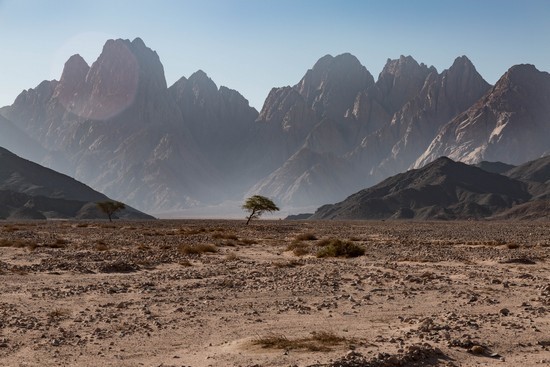 An acacia tree in the
plains of the Red Sea Mountains outside of Hurghada, Egypt, along the Red Sea
Mountain Trail.
An acacia tree in the
plains of the Red Sea Mountains outside of Hurghada, Egypt, along the Red Sea
Mountain Trail.
“There’s something very special about the desert — very harsh
and austere and beautiful in a way that I don’t find in lush,
easy-to-survive-in landscapes,” Hoffler, who’s 39 and resembles a young Elton
John, told me during a walk on the trail just months before the COVID-19
pandemic upended global tourism.
The first parts of the Sinai Trail opened in 2015. In 2018, it
was extended into a 560km loop across the bottom half of the triangular Sinai
Peninsula. Along with the Red Sea Mountain Trail, another long-distance path on
Egypt’s mainland that Hoffler helped the Maaza tribe open in 2019, the trail
has put Egypt firmly in the ranks of a booming hiking movement in
North Africa and the Middle East.
New trails throughout the regionOver the past 15 years, new long-distance trails, some inspired
by the US Appalachian Trail, have been developed in Lebanon, Jordan, Egypt, and
the occupied West Bank, ranging between 480km and 640km in length. Other
long-distance trails are under development in Saudi Arabia, as part of
futuristic megaprojects being created by the kingdom in its western deserts, and
in the autonomous Kurdistan Region of Iraq.
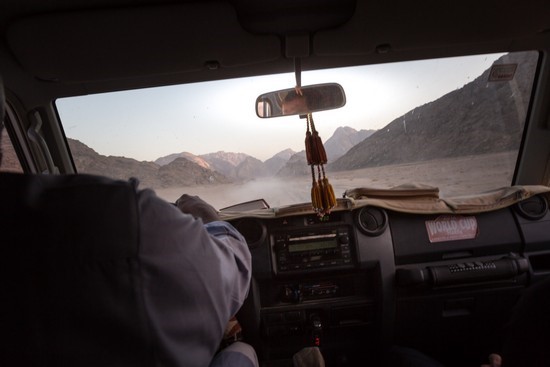 Through the
windshield of a safari truck, the Red Sea Mountain range outside of Hurghada,
Egypt, along the Red Sea Mountain Trail.
Through the
windshield of a safari truck, the Red Sea Mountain range outside of Hurghada,
Egypt, along the Red Sea Mountain Trail.
And now, some of the key players in the hiking movement in the
region are envisioning clusters or transnational trails that, for the first
time, would physically or symbolically link these rediscovered ancient nomadic
pathways and newly forged routes, traversing modern national borders.
For the past three years, Hoffler has been working in
southern Jordan with bedouin tribes and Tony Howard, a hiking and climbing pioneer in
the region, to create a sister trail to the bedouin-governed routes in the
Sinai and the Red Sea Mountains.
There has long been talk, though nothing conclusive has come of
it yet, of a route that would link the Nabatean archaeological sites at Petra,
in Jordan, and the AlUla sites in Saudi Arabia, some 480km to the southwest.
And a new long-distance trail network is taking shape to unite
the Jordan Trail, the Palestine Heritage Trail, and the Lebanon Mountain Trail,
in a partnership with European backers and a trail system in France.
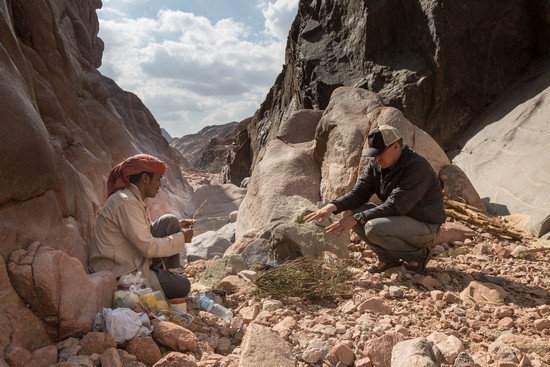 Mohammed Muteer, a
Bedouin guide, and Englishman Ben Hoffler, who worked with tribes to create the
Sinai Trail, the country’s first long-distance hiking path start a fire to
prepare tea in the South Sinai region of Egypt, November 18, 2019.
Mohammed Muteer, a
Bedouin guide, and Englishman Ben Hoffler, who worked with tribes to create the
Sinai Trail, the country’s first long-distance hiking path start a fire to
prepare tea in the South Sinai region of Egypt, November 18, 2019.
All of this echoes the efforts of the
Abraham Path Initiative,
an American nonprofit that has been promoting trail building and trail networks
in the region since 2007, though its main focus now is funding and supporting
work on the Kurdistan trail.
What many of the trails have in common is a determination by
their creators to bring tourists and jobs to distressed villages in the deserts
and mountains. These creators are also intent on preserving long-overlooked
natural wonders, and introducing them to visitors and their own citizens, and
on using the trails to dispel negative perceptions of the historically
turbulent region.
Over the past 15 years, new long-distance trails, some inspired by the US Appalachian Trail, have been developed in Lebanon, Jordan, Egypt and the occupied West Bank, ranging between 480km and 640km in length.
As a cluster, the embryonic network that includes the Jordan,
Palestine, and Lebanon routes could share best practices for the marking of
trails, the establishment of emergency services, and the cross-promotion of
hiking, according to the organizers. Trekking exchanges, however, run into the
reality of geographic and political impediments. Physically linking the trails
in Jordan, Palestine, and Lebanon, for example, is impossible since Lebanon
shares no border with the West Bank or Jordan. And the political obstacles seem
equally insurmountable since Israeli and
Palestinian passport holders are
barred from entering
Lebanon.
To Howard, who spearheaded the popularization of climbing and
hiking in Wadi Rum, a valley in Jordan, in the mid-1980s, the orchestration of
what he calls super trails in the region makes too much sense not to bring to
fruition.
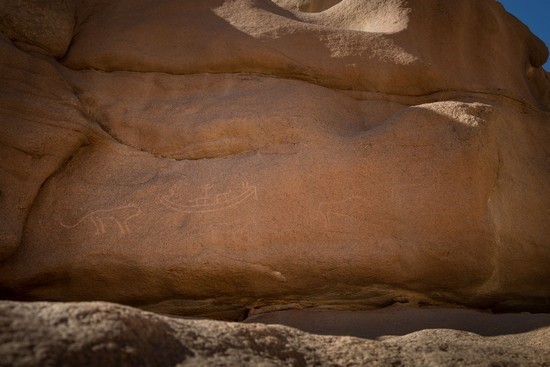 Etchings, said to
date to Roman times, on a rock in the Red Sea Mountains near WadiNagaata in
Egypt, along the Red Sea Mountain Trail.
Etchings, said to
date to Roman times, on a rock in the Red Sea Mountains near WadiNagaata in
Egypt, along the Red Sea Mountain Trail.
“In itself, it’s an exciting thing. It sounds good and it’s easy
to promote, and people will walk it,” Howard said. But trails also benefit the
areas they pass through by increasing tourism and helping to preserve both
nature and culture.
Before the trails were blazed, “there was very little
realization in Jordan that people wanted to visit villages and walk hills,” he
explained. “It started the need to protect some of these areas.”
Bedouin influences and originsAmong all the long-distance routes in the region, Egypt’s trails
are unique in that they are owned and managed by Bedouins, whose nomadic
ancestors, centuries ago, forged many of the pathways on foot and camelback.
Unlike the self-guided trails in Lebanon, Israel, and Jordan, the Sinai and Red
Sea Mountain trails require
bedouin guides.
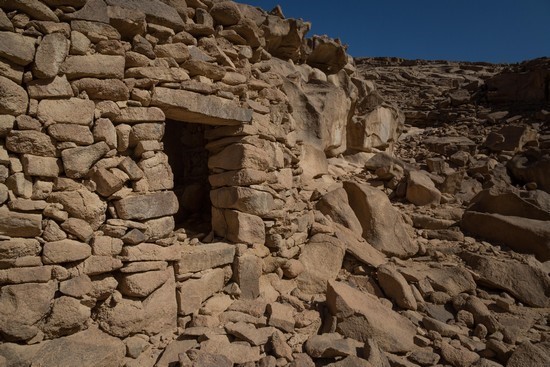 A hermit cell in the Red Sea Mountains near WadiNagaata in
Egypt, along the Red Sea Mountain Trail.
A hermit cell in the Red Sea Mountains near WadiNagaata in
Egypt, along the Red Sea Mountain Trail.
And in contrast to the planned Neom megaproject in northwest
Saudi Arabia, whose website promises 1,200km of trails in the coming years,
features renderings of luxury chalets and boasts of “immersive digital
experiences,” Egypt’s trails try to replicate how the nomads’ forebears moved
through the wilderness. Hikers drink from wells, sleep fireside under the stars
(or in tents), and dine on flatbread baked in acacia coals and seasoned with
mountain salt. The bedouins are relying more on camels to haul the cooking and camping
supplies and colorful woven rugs.
The Sinai Trail was founded by Hoffler and three Bedouin tribes,
whose members serve as guides, cameleers and cooks. And when it was extended in
2018, five more tribes joined the group. The tribes saw the trail as a way to
create sustainable tourism while preserving ancient pathways and traditions
that were fading in this era of smartphones and pickup trucks.
Safety concernsDeveloping these trails was less about clearing new paths than
it was about recovering existing routes that highlighted the myriad landscapes
and legends. It was also about challenging the notion that the Sinai is a
hostile and dangerous place. Egypt has been battling Islamist militants in
North Sinai for much of the past decade.
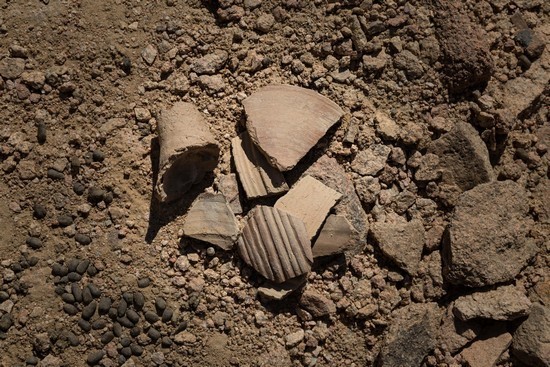 Pottery shards by a hermit cell in the Red Sea Mountains
near Wadi Nagaata in Egypt, along the Red Sea Mountain Trail.
Pottery shards by a hermit cell in the Red Sea Mountains
near Wadi Nagaata in Egypt, along the Red Sea Mountain Trail.
The US government advises against travel in Sinai. For the rest
of Egypt, including the seaside resort of Sharm El-Sheikh in South Sinai, the
State Department advises citizens to “reconsider travel to Egypt due to
terrorism”.
According to the Sinai Trail’s website, “There has never been an
attack on tourists in the interior bedouin parts of South Sinai, where the
Sinai Trail is.” Hoffler maintains that in addition to Egyptian security forces
across the peninsula, hikers have a safety net in an extensive Bedouin network
that keeps tabs by camel, pickup, and foot and shares information about
visitors.
One of our fellow hikers on the Sinai Trail’s western side,
Leena El Samra, a 33-year-old from Cairo who works at a development bank, said
that some of her friends were worried about her taking the hike.
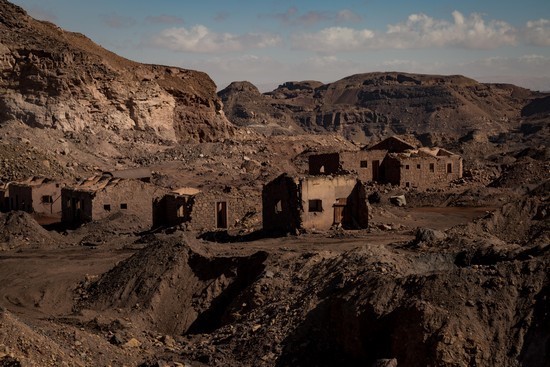 The ghost town of Um
Bogma, along the northwest corner of the Sinai Trail in Egypt.
The ghost town of Um
Bogma, along the northwest corner of the Sinai Trail in Egypt.
“It’s a part of Egypt that’s ignored and we know nothing about,
to some extent,” Samra said, motoring through the gravelly sand. “This is a
part of Egypt where you feel very safe with the people. It’s very nice, it’s
pristine, it’s undiscovered. It’s very different than most of what we do all
over Egypt. And I like building some muscles.”
Samra was among a small but growing circle of Egyptian adventure
travelers and endurance athletes who turned to hiking, running, and competing
in triathlons after the failed revolution and subsequent military takeover
early last decade. Many saw the activities as a way to release frustrations and
exert their independence, or simply to discover their country.
Hiking is still a niche activity in Egypt. The Sinai Trail
hosted a few hundred hikers before the pandemic, which forced the trails to
close for most of 2020. Numbers dwindled to the dozens in 2021 because of
travel restrictions. But more hikers returned this year, including 70 people
from around the world who arrived for a weekend hike in October tied to the UN
annual climate conference, known as COP27, held the following month in
Sharm El-Sheikh.
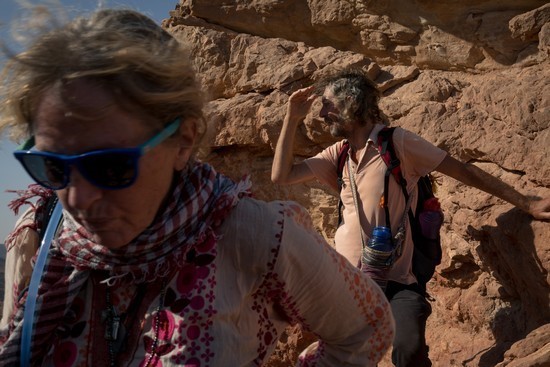 Julie Paterson, a
trip organizer, and Jacobus Nederpelt, a hiker, at the summit of a 200m ascent
through a mountain pass in Egypt.
Julie Paterson, a
trip organizer, and Jacobus Nederpelt, a hiker, at the summit of a 200m ascent
through a mountain pass in Egypt.
If all goes as planned, the Sinai Trail will host its first
end-to-end hike of the 560km route next October.
Returning to traditionsFor the bedouins, the trails are a way to return to their roots
and make a living in the mountains.
During a drought in the 1990s, many Sinai Bedouins moved to
coastal cities or farms in the Nile Valley for work, said Youssuf Barakat of the
Alegat tribe, who spent two years with Hoffler mapping out the trail’s South
Sinai routes and served as a guide during the COP27-related hike in October.
Modernity and the collapse of tourism early in the last decade also pulled Sinai
Bedouins away. Barakat, 36, returned to the mountains to work on the trail
after working as a cook in his family’s restaurant in
Abu Zenima on the west
coast, he said.
The Bedouins have been forced to change, Barakat told us after a
dinner of grilled sheep and vegetable soup, which was followed by Barakat
singing a traditional love song while thwacking a tabla drum.
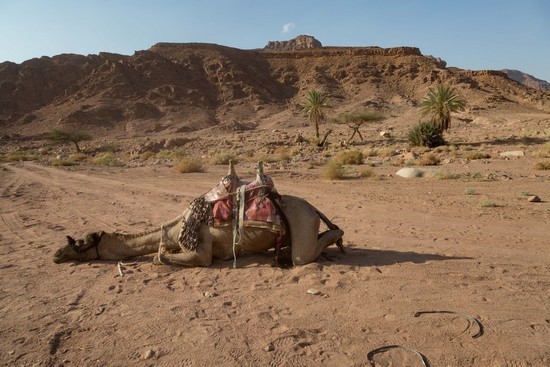 A camel, tied, at lunch stop for hikers along the Sinai Trail
in Egypt.
A camel, tied, at lunch stop for hikers along the Sinai Trail
in Egypt.
“We have internet, we have phones,” he said. Very quickly, he
and his people have “become like the Egyptians.”
With the Sinai Trail, though, Barakat and his fellow
tribespeople have an opportunity to return to their time-honored way of life.
“We start step by step,” he said. “We hope in five, 10 years,
the Bedouin life will come again.”
Read more Travel
Jordan News







